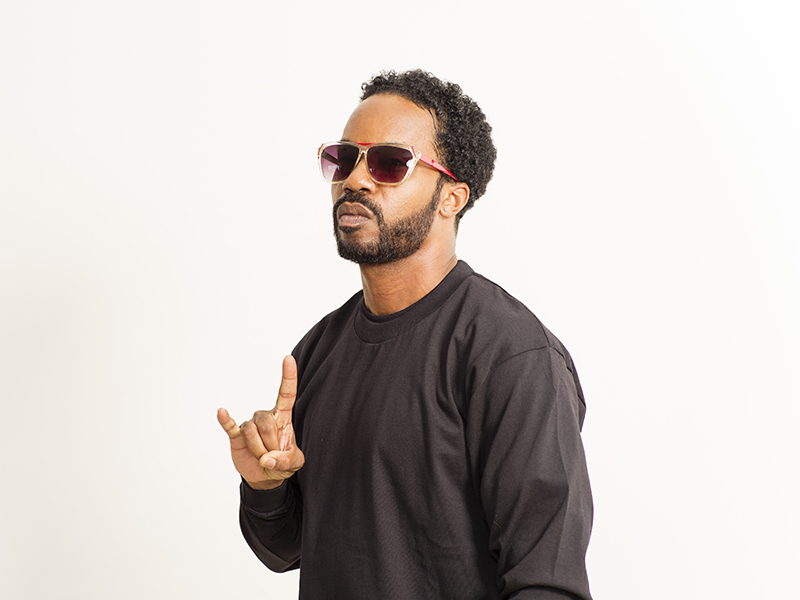
DâM-FunK: The Continuum of Modern Funk
Music Interviews
I first became aware of DâM-FunK’s (Damon Riddick’s) music around the release of his 2009 LP, Toeachizown, when I heard the singles “Mirrors” and “Hood Pass Intact”—tracks with lush, melodically minded synths, tonally unique drum programming, warm, grainy production, and nothing quantized. A Tweet I’d posted celebrating that music gained me a follow from DâM, and when I opened my record shop, Albatross Recordings & Ephemera, four years later, Toeachizown was the first album to sell. Now, DâM-FunK has released and is promoting Invite the Light, his second solo LP, and I was eager to speak with someone who’s brought life back to one of the greatest styles of American music.
While DâM-FunK has been prolific—posting regularly to his Soundcloud (soundcloud.com/damfunk) and collaborating with artists such as Steve Arrington (formerly of SLAVE) and Snoop Dogg—he has released three EPs since Toeachizown, but no full-length albums. This second LP has been long-delayed, but the quality of the music and its realization as a complete volume make it very much worth the wait. Several collaborators appear on Invite the Light, such as Q-Tip, Nite Jewel, Leon Sylvers III & IV, Jody Watley, Ariel Pink, Flea, Novena Carmel and Junie Morrison. All of these performances complement the songs, and DâM says that they are friends whose appearances occurred organically. However, “The next record might be more insular,” says DâM. “I might not have any guests.”
A concern that DâM-FunK has frequently stated publicly, in interviews and on social media, is his desire to create music that is “timeless.” I discern that the tracks on Invite the Light sound as though they could have come from prime eras of several different styles—incorporating elements of electro and R&B, for example, but ultimately remaining true to modern funk’s overall sonic aesthetic. Invite the Light’s first single, “We Continue,” consists of—among other elements—salient snare hits, squelchy bass, DâM’s midrange vocals, uplifting lyrics and full synth chords. Meanwhile, a mid-album track like the instrumental “The Hunt & Murder of Lucifer,” with its crushed, warbly low-end, owes as much to groove music as it does to classic electronic horror scores. DâM-FunK references “Surveillance Escape” and “Virtuous Progression” as personal favorites on Invite the Light. “[Those are] songs I was glad to be able to put on this record,” says DâM-FunK. Invite the Light was recorded where the majority of DâM-FunK’s music is created—in his home with analog keyboards and outboard gear. He records live to ProTools, employing tricks like running a drum machine to cassette tape to get some grit.
With technology and the subject of conveying thoughts and ideas in mind, DâM-FunK has maintained a steady social media presence and has actively participated across the relevant platforms over the last several years. I was curious about how he determines what to share, whether he imagines that he’ll always be as publicly accessible as he is currently—and if he wants to be. “I just try to keep it [from being] too personal, but I do share some things I go through,” he says. “[In] this new era, there’s a connection with the people and a way to share information and ideology. Some people recoil from social media, but it is a way to stay ‘relevant,’ if you will. I just use it as tool to connect with good people.”
As for connections, funk has taken DâM-FunK around the world, has inspired his name, and represents more than a single sound or series of stylistic hallmarks and cues. I was interested to know his thoughts on the nature of funk, including but extending beyond the musical aspect, its survival and how it differs from other genres. “I feel that funk gives more freedom,” says DâM-FunK, citing elements the genre embraces, such as “guitar solos that would never be welcome” in environments such as R&B radio. “To me, funk feels like one of the—not final, but later—tiers of expression in Black music, but also all music.” He cites the diverse backgrounds of many of the genre’s premier groups (consider Funkadelic, Sly & The Family Stone and, later, The Revolution). “They always had a cross-section of different people involved,” DâM-FunK says. Considering funk as a worldview, DâM regards it as “a positive music, but it has other emotion in it as well.” Of funk’s ideal future: “We start telling stories again,” says DâM-FunK, “like Sly [Stone] did in ‘A Family Affair’—different topics searched in a subliminal way.”
This kind of vision serves DâM-FunK’s interest in making his music timeless. It has appeal beyond any specific age, region or demographic. “I’ve always tried to be internationally thinking when it comes to my music—intergalactic, even,” says DâM-FunK. “I just give the experiences that I’ve lived and what’s truly in my heart.”
Invite the Light, out Sept. 4 on Stones Throw Records, boasts vinyl packaging that is as appealing as the music. DâM-FunK will be playing in Salt Lake at Urban Lounge on Sept. 13 with a three-piece band consisting of DâM-FunK, Reggie Reg and E-Day. Of the upcoming live set, and all of his work—which is modern funk, but sometimes labeled as “boogie” or “electronic”—DâM-FunK simply says, “It’s serious funk.”
